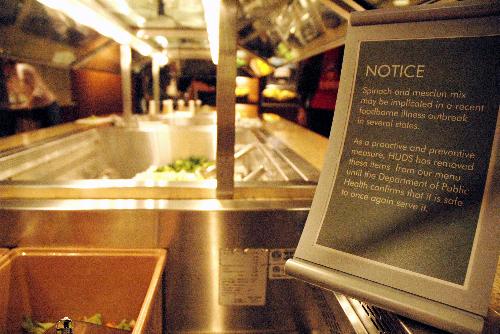
Outbreak In the Salad Bar
Signs on salad bars from Pfoho to Mather explaining Harvard’s curious lack of roughage are putting a damper on the otherwise exquisite, or at least generally non-lethal, Harvard College dining experience. An E. coli outbreak traced to California bagged spinach has caused one known death, is suspected of causing two others, and has made people sick from New Mexico to Maine.
No E. coli cases have been reported in Massachusetts. But when dealing with the possibility of a gastrointestinal illness marked by such symptoms as bloody diarrhea, cramping, and, um, death, Harvard University Dining Services (HUDS) took what HUDS Assistant Director for Marketing Crista Martin called a “better safe than sorry” approach. Following a Sept. 15 warning from the Massachusetts Department of Public Health, HUDS pulled pre-bagged greens from the menu. Still, odds are nobody’s going to end up puking in Stillman at least for anything but the usual punch + vodka + TLR misadventures.
Why so fast, HUDS? Harvard has already had several epidemics strike campus: In 1948, an unidentified virus sickened more than 1,000 undergrads and was eventually traced to the Kirkland House kitchen. Most recently, in 1994, a 24-hour stomach virus struck nearly 200 freshmen, forcing the College to send students to outside hospitals as it dragged on a public health investigation. The response to 1994’s outbreak formed the basis for UHS’s current protocol.
And post-9/11 fears led administrators to refine those plans. After the 9/11 attacks, the threat of anthrax and other biological agents led administrators to consider the high risk of contagion in residential colleges. They try to preempt, rather than acting after the fact.
The Hot Zone
Late in the evening of Dec. 8 of 1994, freshmen began streaming into Stillman Infirmary; thirty students would receive IV treatment on site. UHS Director David S. Rosenthal ’59, who was also director at that time, recalls that he didn’t return home until 48 hours after the start of the epidemic.
From the start, Rosenthal said UHS, the Centers for Disease Control (CDC), and the Massachusetts Department of Public Health pointed to the Union—then the freshman dining hall—as a common factor among the victims. But Harvard authorities were at first reluctant to consider the food as the cause. Michael P. Berry, director of dining services at the time, spoke to The Crimson three days after the crisis began.
“There is no evidence that this was a food-borne illness,” he said
Laboratory work eventually revealed the culprit to be the Norwalk virus, a gastrointestinal virus transmitted to students through contaminated salad bar food. HUDS removed eggs and pasta from the bar because of elevated bacteria levels, although those levels were not high enough to have caused the crisis, according to a Crimson report.
Dartmouth College suffered a similar epidemic the week before Harvard did, suggesting a pre-Harvard source of contagion. At the time, Dartmouth turned down Harvard’s request for further information on Dartmouth medical crisis and flaunted CDC requests to do so.
The Crimson reported at the time that UHS’s resources were taxed to the limit, and students were turned away due to lack of facilities. Others were sent on a triage basis to Mount Auburn Hospital and Massachusetts General Hospital for further care. At the time of the crisis, UHS had 16 beds. Today, it has ten. In the years following the epidemic, UHS has “looked at where people could be housed in the event of a heath crisis or a pandemic,” Rosenthal said.
State of Stillman
More than a decade after the epidemic, contagion management has become a much more coordinated affair. Fineberg Professor of the Practice of Public Health Howard K. Koh, who is also a former Commissioner of the Massachusetts Department of Public Health, cites unifying “themes” of combating disease, practiced by Harvard during the 1994 outbreak and refined during anthrax scares post-9/11. He describes Harvard’s new protocol in sweeping terms: “Monitoring the victims—probably with the Cambridge Health Department, lab testing to trace back to original source, caring for the sickest students, and cooperating with area hospitals. Prevention and prophylaxis [identifying and preemptively treating at-risk but not yet ill students] is always a concern.”
Koh went on to cite a major difference between the health crisis efforts of today and those of ten years ago. “Every school of public health now has a center for public health preparedness. Federal authorities came to realize after 9/11 that there was not enough attention against the threat of what they call an all-hazard approach,” he says, referring to biological warfare.
These centers, funded by the CDC, have “grown considerably” in recent years, says Koh. Both he and Rosenthal mention an incident support team, consisting of “all the major areas of the university; human resources, health care, Harvard police, about ten or twelve organizations.” The team runs through mock disasters and promotes collaboration between the fire department, police, and other emergency responders.
In the event of a biological threat, Harvard seems to have its bases covered. But Koh warns against complacency. “The most critical part of public health is upholding standards for prevention,” he says. “We always assume that the food we eat and the water we drink and the air we breathe is all safe, and that is not always the case.”


